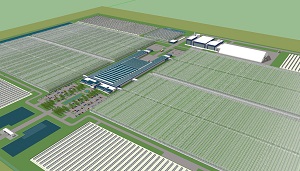GrowGreen Power to develop sustainable trifecta
 GrowGreen Power, Inc. yesterday announced plans to develop a 43.7-megawatt power plant that runs on biomass and solar thermal, and the site will also host a 50-acre greenhouse. It’s the first such project for the company and likely the first such project—period. The project will be developed in the Piedmont area of North Carolina.
GrowGreen Power, Inc. yesterday announced plans to develop a 43.7-megawatt power plant that runs on biomass and solar thermal, and the site will also host a 50-acre greenhouse. It’s the first such project for the company and likely the first such project—period. The project will be developed in the Piedmont area of North Carolina.
The company chose the location after searching for more than a year.
“North Carolina is an ideal spot for us,” Bradley Nixon, GrowGreen CEO, said in a press release.
The 43.7-megawatt system will supply roughly 37 megawatts to the grid, and the greenhouse will produce hydroponically grown tomatoes, to start. The project is expected to cost $250 million and to create 300 permanent jobs in the region.
The company’s optimum size for such projects at this point is 100 acres, according to GrowGreen spokesperson Sean Lehman.
“The initial plan is 50 acres with quadrants. Then we’ll expand to 100 acres,” he said.
Different technologies will work together to produce energy.
“Our architects and engineers have figured out a way to incorporate the panels into the greenhouse in a way that won’t obstruct the plants from getting sunlight,” Lehman said.
Though, some GrowGreen projects could include ground-mounted arrays.
Biomass will provide the majority of the generation, but the two systems will power the same turbines. The company has not decided which solar thermal technology they’ll use yet.
“We’ll narrow that down when we find out the location,” he said.
North Carolina is a significant producer of lumber thanks to its rich-soil climate. As such, the biomass generator will primarily feed on wood waste and wood pulp, Lehman said.
“There’s about seven times as much wood waste as needed.”
The biomass facility will have a low-carbon footprint, according to Lehman.
“We’re working with a company to sequester the carbon dioxide. It will give us very close to a zero carbon footprint. Obviously, the idea is to cut down on the emissions to the highest level possible,” he said. “We’ll also reuse some of that carbon dioxide and recycle the waste heat to heat and cool the greenhouse.”
Image courtesy of GrowGreen.



